www.magazine-industry-usa.com
24
'23
Written on Modified on
Ageing more slowly in space?
Microscopy application in mini-space satellite to study human cells.
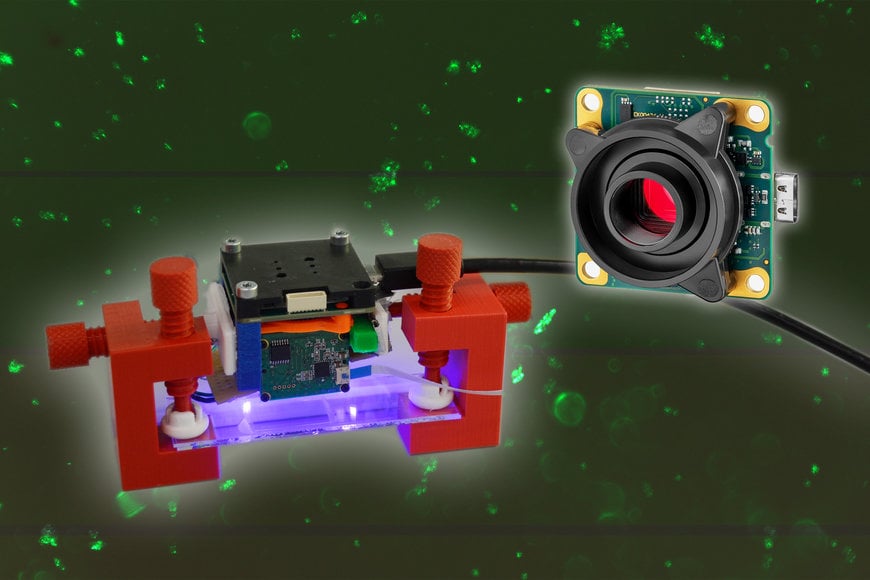
The importance of space exploration is increasing, and more and more astronauts are cavorting in space. But what effects does weightlessness have on the ageing of the human body? How do certain cells develop under milligravity and microgravity conditions, such as those found on small moons and asteroids? The Swiss Artificial Gravity Experiment (SAGE) is dedicated to this research task. A team of students from various Swiss universities (Academic Space Initiative Switzerland ARIS) wants to investigate how the ageing process in humans changes in space and how cellular senescence influences the development of ageing and age-related disorders. The young researchers are currently designing the construction of a satellite platform for a corresponding biological experiment, which must meet extreme requirements. The fully automated system will serve as a long-lasting test field under the required space conditions and act as a centrifuge for the human cell lines to be studied. At the heart of this CubeSat solution is a fluorescence microscope equipped with a microfluidic chip and a high-resolution USB3 camera from the uEye XLE family.
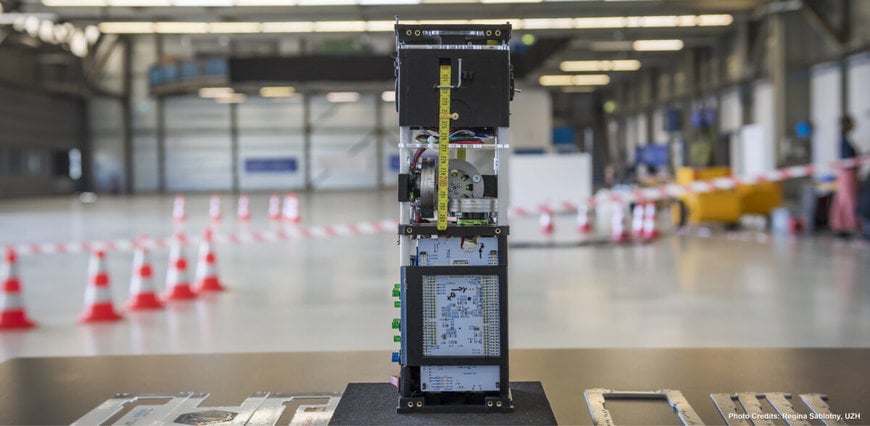
In the human body, ageing processes take place at the cellular level, which are referred to as senescence. This is a phenomenon where cells stop dividing and secrete inflammatory factors. "Building on research by NASA and many other groups around the world, there is reason to believe that cells age more slowly in microgravity than on Earth. This effect can be measured by certain proteins and mRNA, which are emitted during cell ageing. Messenger RNAs (mRNAs) have emerged as essential factors contributing to or preventing cellular senescence. With a fluorescent marker, this mRNA can be labelled and, when irradiated with the right light, it is made to glow. The complete experiment is carried out over a period of two months in a volume of only ten cubic centimeters. To measure and analyse the necessary processes under these conditions, we need a particularly reliable and compact fluorescence microscope," explains SAGE Payload Engineer Jonas Schlör.
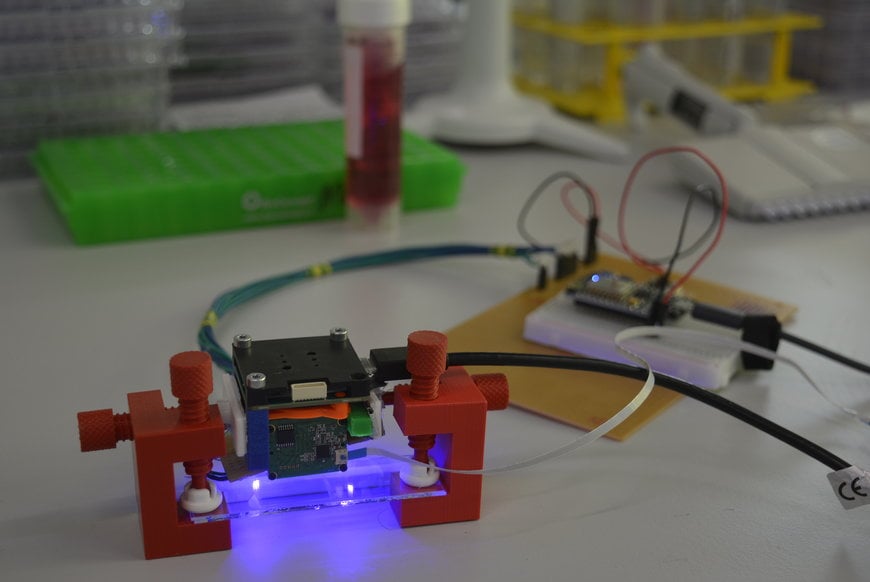
Fluorescence microscope with USB3 uEye XLE board level camera from IDS.
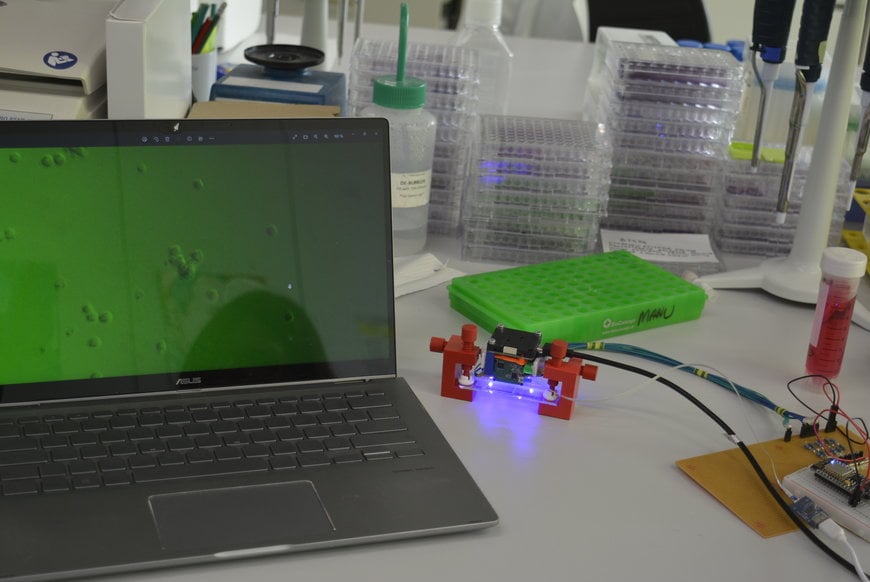
The screen shows the cells captured by the camera.
For the laboratory tests, a U3-38J1XLE-C-HQ was used in the microscope. The camera captures fluorescent mRNA from human cells placed on a microfluidic chip.
Microfluidic chips enable the miniaturisation and integration of complex laboratory functionalities on a single chip. This saves space and reduces the need for samples. Microfluidic chips contain engraved or shaped microchannels through which the fluid to be analysed can flow.
The use of microfluidic channels allows samples in very small volumes. Due to the high resolution of the camera with the rolling shutter sensor IMX415 from Sony, individual cells can be distinguished from each other. The high pixel density of the sensor in particular makes it possible to display individual cells with a diameter of only 15 μm. A blue LED energizes the cells in a microfliodic chip. These emit green light of varying intensity depending on the rate of senescence. Cells with a higher senescence rate emit more fluorescent proteins and are therefore brighter. An optical filter allows only the green light from the cells to pass through the lens onto the camera. This allows not only the general senescence rate of the cells to be determined, but also the specific number of living cells.
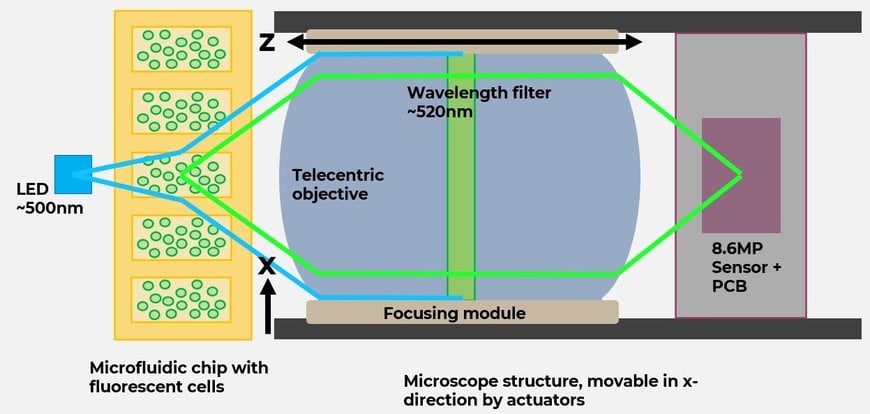
Microscope scheme for cell research with uEye XLE camera, microfliodic chip and LED
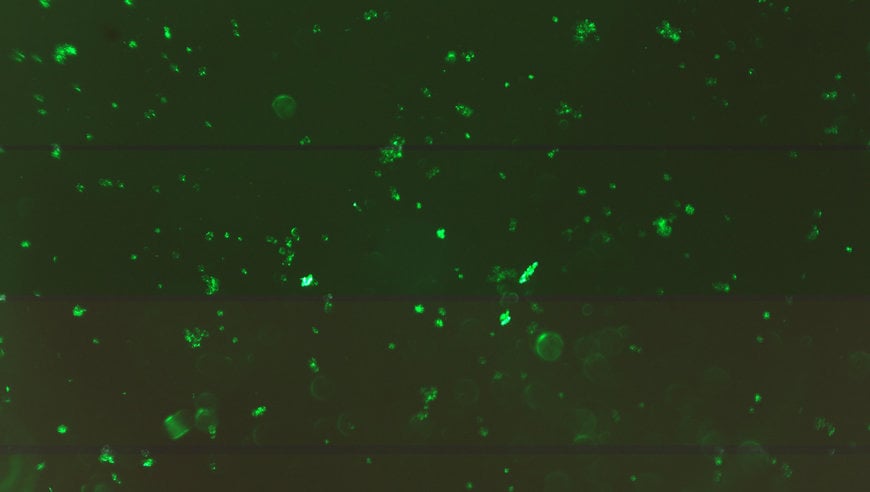
The cells emit different amounts of green light depending on the senescence rate. Cells with a higher senescence rate emit more fluorescent proteins and are therefore brighter.
"The data obtained is thus very meaningful and scientifically relevant, as comparable research has not been conducted in this way before," explains Jonas Schlör. In addition, a complex apparatus, which is otherwise necessary for fluorescence microscopes, can be dispensed with and a lot of space can be saved. "The camera also features numerous software-related setting options, such as exposure times or colour filters, which means that a high degree of flexibility can be maintained throughout the design process." It also has to meet the tough demands of the external environment. These include the rocket launch with its very intense vibrations and, of course, the conditions in orbit under vacuum and cosmic radiation.
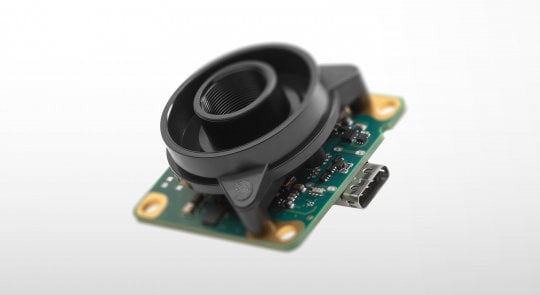
High-resolution USB3 camera of the uEye XLE family from IDS
With 8.41 MPixels and 4K resolution, the U3-38J1XLE Rev.1.1 is particularly suitable for this type of visualisation task. With the 2x2 binning feature, it is possible, if necessary, to reduce the amount of data to be transmitted by a factor of four and thus increase both the light sensitivity and the frame rate. Sony's IMX415 rolling shutter sensor delivers high-resolution data for detailed image analysis. Due to its extremely space-saving design, the IDS camera can be optimally integrated into this embedded application. The camera is controlled by a microcontroller, which processes and compresses the data while still on the satellite, after which it is to be sent to Earth. The software as well as the control algorithms are developed and tested by the students of the Swiss Academic Space Initiative themselves.
The demands on the system or the CubeSat are high: The latter must both provide the attachment points for the subsystems and components and ensure the structural stability of the satellite - from insertion into its launch vehicle to the end of its service life. All components must withstand the physical stresses generated by the launch vehicle during ascent and later the radiation and temperature fluctuations in space, while being as light as possible. The satellite prototype has already delivered first promising results.
Outlook
The experiment is designed to run for 3 years. Based on the research results, various scenarios are conceivable. First, for example, the scientists would like to find out whether certain therapies could improve the astronauts' well-being. But senescent cells can also be drivers of various diseases that make life difficult for people, especially in old age - such as dementia, arteriosclerosis, diabetes and arthritis. In addition, they are suspected of contributing to tumour progression. According to one study, SARS-CoV-2 may also be a trigger for senescence - a possible explanation for Long Covid's persistent symptoms.
The Swiss Artificial Gravity Experiment could provide interesting approaches for possible therapies. More and more IDS cameras are thus making a contribution to health promotion worldwide. "A field of application that is close to our hearts," emphasises IDS founder and owner Jürgen Hartmann.
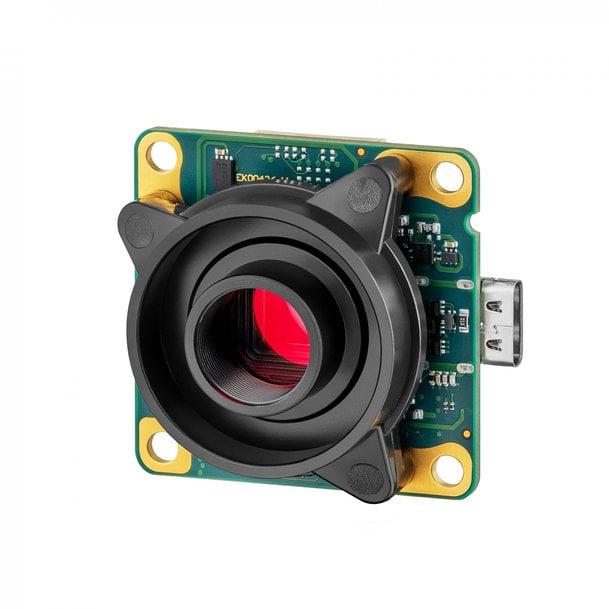
Camera
uEye XLE USB3 Vision - consistently cost-optimised
-Interface: USB 3
-Model: U3-38J1XLE-C-HQ
-Sensor type: CMOS Colour
-Manufacturer: Sony
-Frame rate: 25.1 fps
-Resolution: 3864 x 2176 px
-Shutter: Rolling-Shutter
-Optical class: 1/3"
-Resolution: 8.41 MPixel
-Dimensions: 36.0 x 36.0 x 21.0 mm
-Frame rate: 25.1 fps
-Resolution: 3864 x 2176 px
-Shutter: Rolling-Shutter
-Optical class: 1/3"
-Resolution: 8.41 MPixel
-Dimensions: 36.0 x 36.0 x 21.0 mm
-Weight: 13 g
-Connector: USB Type-C
Client
aris brings together studentsfrom Swiss universities who are passionate about space exploration. Formed around ETH Zurich, the members address technical challenges by combining theory and practice. Not only are rockets being built, but with SAGE (Swiss Artificial Gravity Experiment) their first 3U-CubeSat satellite is also being developed.
-Connector: USB Type-C
Client
aris brings together studentsfrom Swiss universities who are passionate about space exploration. Formed around ETH Zurich, the members address technical challenges by combining theory and practice. Not only are rockets being built, but with SAGE (Swiss Artificial Gravity Experiment) their first 3U-CubeSat satellite is also being developed.

